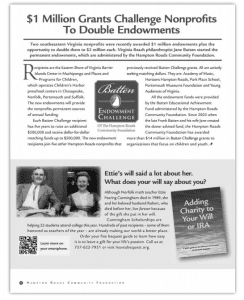Why A Donor's Age Matters In Fundraising


Full Platform Overview Chat With Us



Full Platform Overview Chat With Us




Why is knowing the average age of your donors keenly important? Because, obviously, 75-year-olds don’t subscribe to Teen Vogue. Our interests change throughout our lives. We change throughout our lives. Age matters in fundraising. You as a 20-something are different from you as a 40-something – are different from you as a 60-something – are different from you as an 80-something. And not just different physically, but different emotionally.
Geriatric specialist, David Solie, author of How to Say It to Seniors, points out that as people age into their 70s, two issues become paramount:
“To maintain control is a primary driver for the elderly,” he writes, “because each day, they feel losses—of strength, health, peers, and authority—that are staggering.” But there’s something “equally compelling … on the old-age agenda—the search for a legacy.” Be aware: “Every day, every hour, whether they mention it or not, the seventy-plus age group is reviewing their lives.”
This intense internal life review has important implications for fundraising. Ultimately, seniors who successfully complete their life review will want, says Solie, “to be remembered for the things
[they] valued most.” Charities can help with that existential quest.

A permanently endowed fund at your local community foundation is as close as most of us can come to immortality.
Endowed funds just purr on and on, forever.
The oldest endowed fund I know personally is parked at Oxford University. William of Durham’s will established the endowment in 1249. Today, William’s fund (he was a childless priest) stills makes scholarships possible, more than 760 years later.
Technically, that stretch of time isn’t “forever.” For many, honestly, it’s close enough.
As the massively influential UK copywriter George Smith (1940–2012) advised, “All fundraising copy should sound like someone talking.”
Not a lecture. Not an essay. Not a sales brochure. Just a talk, between two friendly people concerned about something important to the community – whether that “community” is local, regional, national, or international.
In order to have that conversation, you, as a writer of a newsletter, need to “see” (mentally) the person with whom you’re speaking. “Try and get a fix on that individual,” Smith wrote, in his Tiny Essentials of Writing for Fundraising. “You are talking to a real person, not a list.”
Smith had one other crucial but easy-for-everyone bit of advice: “Think of your mum every time you write a piece of fundraising communication. She is probably the likeliest model of the average donor you will ever meet.”
When I write fundraising materials, I often envision my motherin-law, Jane. She’s in her later 80s.
Is Jane’s age typical? I asked a client, a large hospital system in California, to tell me what its data revealed. The hospital reported back:
I asked Jeff Brooks, “What do you think is the average age of a U.S. donor?” You met Jeff earlier in this book. He has access to vast amounts of current data from direct mail appeals.
“I think saying 65 and up,” he answered, “is about as accurate as possible for an across-the-board number.”
Jeff did allow that the average nonprofit donor’s age “varies by organization and sector.” But for sure: “One thing we’ve seen is that charitable giving as a sustained lifestyle-type activity isn’t meaningfully found until around age 55. The behavior picks up steam in the following years,” said Jeff, “gets truly meaningful around 65, keeps growing, then starts to drop some time after 75.”
Ages 55–75: that’s a 20-year window of high returns.
Jeff also noted, so you don’t draw the wrong conclusion: “The drop-off at the upper end is caused by ‘involuntary lapsing.’” I.e., death.
You know who’s just beginning to turn 65, as I write this book? The baby boom generation: people born between 1946 and 1964, during the procreative orgy that exploded after World War Two. In that conflict, 60 million of our species died. The subsequent natal frenzy minted 76 million new humans in the United States alone. Those same newborns are now aging into their prime charitable years.
Jeff Brooks, who I cited above, had a postscript: “The smart thing to do is to increase your donors, ages 55–65. They have higher average gifts and long life expectancy, which gives them the best long-term value. If we could get all the misguided energy for finding ‘young donors’ aimed at this group, it would be a very good thing.”
In 2012, AIGA, America’s professional association for graphic designers, issued a recommendation based on research: that you use 14-point type for body copy such as articles and direct mail.
“Leave a legacy” isn’t just a bunch of words. A donor leaving a charitable bequest is saying something about a lifetime of values, interests, beliefs, concerns, hopes, prayers, disappointments, regrets, mistakes, gratitude and wonder. A fund endowed by a bequest can theoretically last forever, doing good in perpetuity, in someone’s name.
(Or as “anonymous,” if you prefer; but where’s the fun in that?) The oldest endowed fund I know was established in the Middle Ages, at Oxford in 1249. It’s still sending poor bright kids to university today.
This post is an except from Tom’s upcoming book “Making Money with Donor Newsletters 2nd Edition.”

Comments